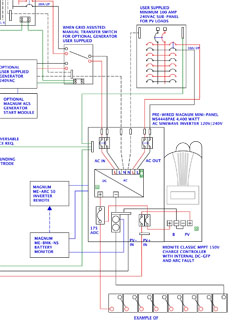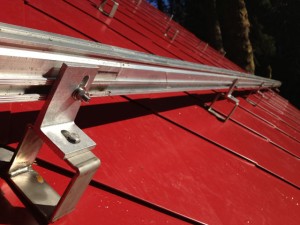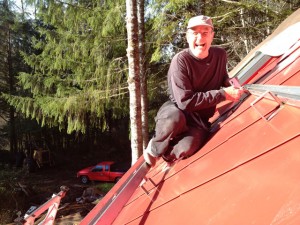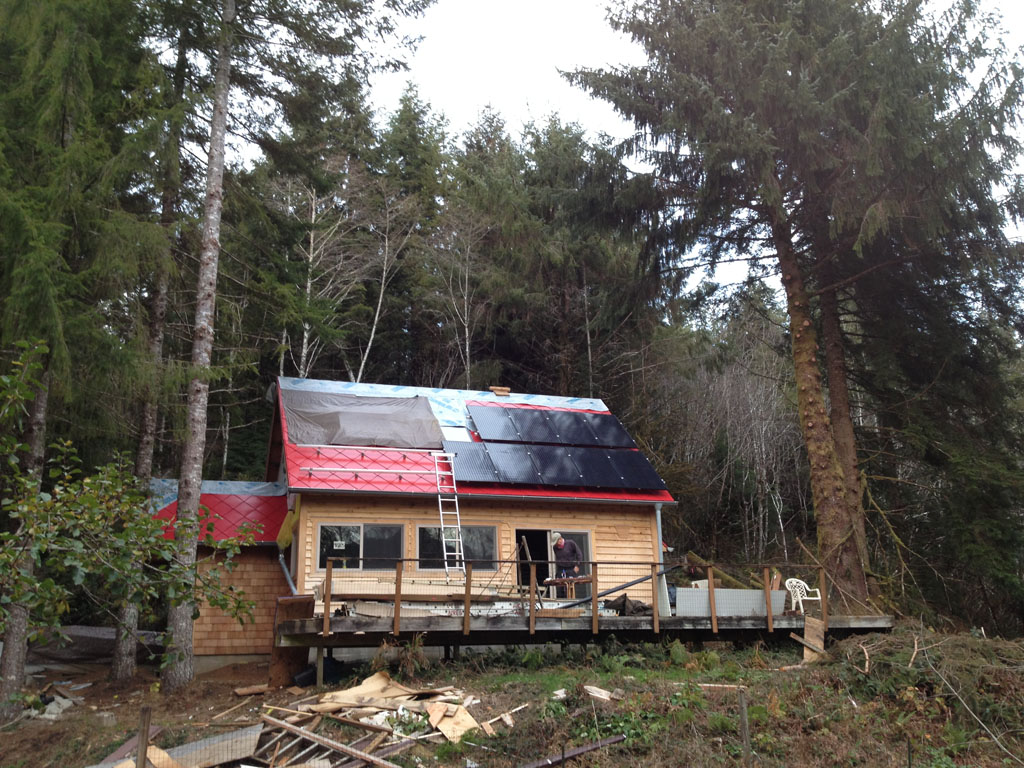Back when we bought the property, one of the problems we were made aware of was that there was no electricity to the house. The previous owner had used it as a vacation cabin, and never put it in. The reason that was considered a “problem” is because the cabin is a thousand feet from the road (and existing power lines) and connecting would involve running extra powerlines and poles across the property, through the woods and over the creek, at a cost of about $20k.
Emily wasn’t too thrilled about that idea, since we’d be forever losing power and having to pay to have lines fixed when tree limbs came down in storms. We thought about it, I did the research, and realized that we could get an off-grid solar power system for a few thousand less than the cost of connecting to the utility. Suddenly, one of my childhood dreams was possible: a solar house!
 After doing a lot of research, I realized that this is something we could do ourselves and learn something from, so I ordered the parts. Since the roof needed to be replaced, those parts sat under a tarp in my driveway at our current apartment for MONTHS as the roof project dragged on (more on that in a later post). Admittedly, that made me a little nervous, but I figured as long as I told no one what that car-sized pile of stuff was, it was safer than possible getting stolen out at an abandoned construction site in the countryside. The parts were in several palletized crates containing a ton of sealed AGM batteries (literally, a scratch over 2,000 pounds), a computerized MPP power controller, a pure sine wave inverter, twelve 250-watt solar panels, and a slew of cables and connections. The plans, instructions, and wiring schematics came electronically.
After doing a lot of research, I realized that this is something we could do ourselves and learn something from, so I ordered the parts. Since the roof needed to be replaced, those parts sat under a tarp in my driveway at our current apartment for MONTHS as the roof project dragged on (more on that in a later post). Admittedly, that made me a little nervous, but I figured as long as I told no one what that car-sized pile of stuff was, it was safer than possible getting stolen out at an abandoned construction site in the countryside. The parts were in several palletized crates containing a ton of sealed AGM batteries (literally, a scratch over 2,000 pounds), a computerized MPP power controller, a pure sine wave inverter, twelve 250-watt solar panels, and a slew of cables and connections. The plans, instructions, and wiring schematics came electronically.
As has happened numerous time on the project, we got lucky. While I was driving to the monthly beekeeping meeting with some beekeeper buddies of mine, I was talking about this stuff and one of them (Jeff) mentioned that before he retired, he sold and installed solar power systems for 20+ years. There was a pause, and I asked, “Um, do you want to help me install mine.”
“I thought you’d never ask,” he smiled.
 So Wednesday saw the fruition of months of planning and preparation, as we finally installed the panels on the roof. We’ve had three peculiar days of unseasonable sunny weather, and it was gorgeous. It took us all day to install them: first, we had to mount the aluminum racking system to the stainless steel brackets that are integrated with the roof. The brackets are quite stout; they pass under the steel shingles and are bolted through the decking into solid wood blocking below, and they are fabricated out bent 3/16″ stainless steel. You can, quite literally, hang from one.
So Wednesday saw the fruition of months of planning and preparation, as we finally installed the panels on the roof. We’ve had three peculiar days of unseasonable sunny weather, and it was gorgeous. It took us all day to install them: first, we had to mount the aluminum racking system to the stainless steel brackets that are integrated with the roof. The brackets are quite stout; they pass under the steel shingles and are bolted through the decking into solid wood blocking below, and they are fabricated out bent 3/16″ stainless steel. You can, quite literally, hang from one.
 Once we got the aluminum rack on and level, we had to hoist the panels into place. They are four feet wide by five and a half tall, so are a bit awkward to handle. Luckily, they are really light. Special clips bolt the panels down to the racks, and there are grounding clamps that tie the whole system back to the building ground. Then, we route the electrical leads from each panel together as shown on the schematic. The 12 panels are broken down into groups of three panels wired in series, which are then connected to a collector box that is wired in parallel, giving us a 3000-watt, 48-volt DC power array.
Once we got the aluminum rack on and level, we had to hoist the panels into place. They are four feet wide by five and a half tall, so are a bit awkward to handle. Luckily, they are really light. Special clips bolt the panels down to the racks, and there are grounding clamps that tie the whole system back to the building ground. Then, we route the electrical leads from each panel together as shown on the schematic. The 12 panels are broken down into groups of three panels wired in series, which are then connected to a collector box that is wired in parallel, giving us a 3000-watt, 48-volt DC power array.
This might be a good time to plug (no pun intended!) Wholesale Solar, who sold me the equipment. They have been very helpful with supplying the right stuff, well built and promptly delivered, and their tech support has been great when I’ve had questions.
 That, combined with Jeff’s experience as an installer has been a godsend. He had such a good time that he couldn’t stop smiling. When he offered to help, i assumed I was getting sage advice, not a guy on the roof! Turns out, he was also a rock climber back in the day, and he showed up with harness and tools and safety gear, and was jumping around like the 20-years olds that are normally helping me. He admitted that he was going to take some ibuprofen when he got home.
That, combined with Jeff’s experience as an installer has been a godsend. He had such a good time that he couldn’t stop smiling. When he offered to help, i assumed I was getting sage advice, not a guy on the roof! Turns out, he was also a rock climber back in the day, and he showed up with harness and tools and safety gear, and was jumping around like the 20-years olds that are normally helping me. He admitted that he was going to take some ibuprofen when he got home.
We finished the day with 75% of the array in place as we ran out of daylight, but that was OK, as the last three panels have to wait until I get the last part of the roofing on. Now we can go inside and wire up the back end of the system, which we will talk about in a later post.



One Response to Of photovoltaics, inverters, and batteries